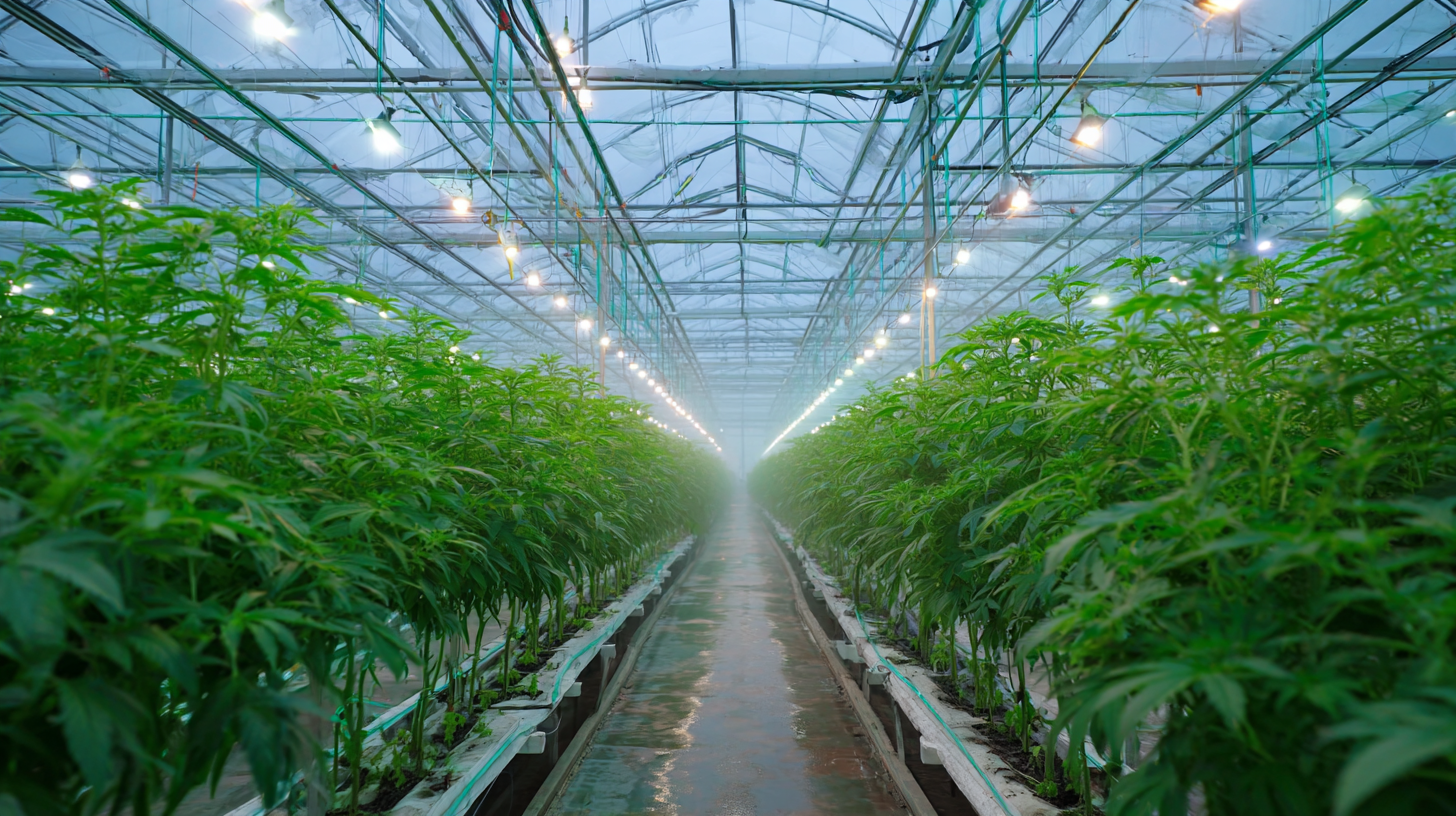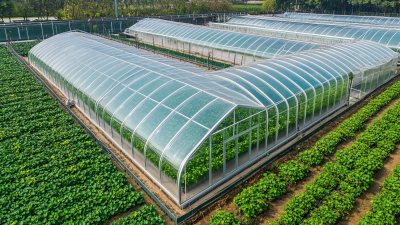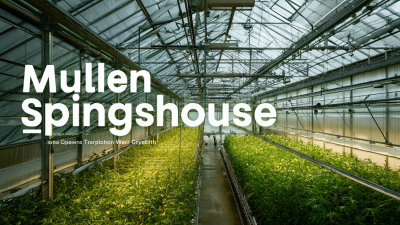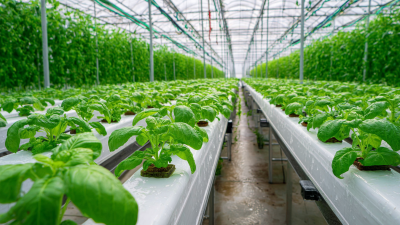
Exploring the Future of Farming with Innovative Agricultural Greenhouse Techniques
As global population continues to rise, projected to reach approximately 9.7 billion by 2050, the demand for sustainable and efficient food production methods becomes increasingly critical. Innovative Agricultural Greenhouse techniques offer a promising solution to meet these demands while minimizing environmental impact. According to a report from MarketsandMarkets, the global greenhouse market is anticipated to grow from $33 billion in 2020 to $68 billion by 2025, driven by increasing awareness of sustainable farming practices and the need for year-round crop production. These advanced greenhouses provide controlled environments that optimize plant growth, reduce water usage by up to 90%, and enhance crop yield, making them essential in addressing food security challenges. By integrating digital technology into greenhouse systems, farmers can not only improve productivity but also gain valuable insights through data analytics, paving the way for the future of sustainable farming.

The Role of Technology in Modern Agricultural Greenhouses
 The role of technology in modern agricultural greenhouses is pivotal in addressing the complexities of today's farming challenges. Intelligent environmental control systems, which integrate sensors, automation, and artificial intelligence, are revolutionizing crop production. These systems enable precise monitoring and management of environmental conditions, ensuring optimal growth while minimizing resource use. Reports indicate that greenhouse environments can reduce energy consumption by up to 50% when utilizing innovative technologies, significantly impacting operational costs and sustainability efforts.
The role of technology in modern agricultural greenhouses is pivotal in addressing the complexities of today's farming challenges. Intelligent environmental control systems, which integrate sensors, automation, and artificial intelligence, are revolutionizing crop production. These systems enable precise monitoring and management of environmental conditions, ensuring optimal growth while minimizing resource use. Reports indicate that greenhouse environments can reduce energy consumption by up to 50% when utilizing innovative technologies, significantly impacting operational costs and sustainability efforts.
As greenhouse farming gains traction globally, regions such as Shanghai are investing in comprehensive policy frameworks aimed at fostering innovation and sustainability. The city's vision for the future of horticulture emphasizes technology adoption to enhance production efficiency and meet the demands of urban populations. In the Netherlands and Kazakhstan, cooperation among agricultural companies is catalyzing the exchange of innovative practices and technologies, showcasing the international push towards more efficient and sustainable greenhouse methodologies. With the global population projected to reach nearly 10 billion by 2050, the integration of modern agricultural technologies is not just an option but a necessity for achieving food security and environmental sustainability.
Sustainable Practices in Innovative Greenhouse Farming
The advent of innovative greenhouse techniques heralds a new era in sustainable agricultural practices. By leveraging advanced technologies such as hydroponics, vertical farming, and smart climate control systems, farmers can optimize resource use while minimizing their environmental footprint. These methods not only enhance crop yields but also reduce water consumption and eliminate the need for harmful pesticides. As urban areas expand, greenhouse farming provides a viable solution to food production within city limits, promoting local sourcing and reducing transportation emissions.
Additionally, the integration of renewable energy sources, such as solar panels and wind turbines, into greenhouse designs exemplifies a commitment to sustainability. These technologies allow farms to operate autonomously, relying on clean energy to power their operations. Sustainable practices, such as composting organic waste and utilizing rainwater harvesting, further contribute to the resilience of greenhouse systems. By embracing these innovative approaches, the future of farming can significantly reduce its ecological impact while ensuring food security for a growing global population.
Exploring the Future of Farming with Innovative Agricultural Greenhouse Techniques
This chart represents the potential yield improvements in greenhouse farming techniques compared to traditional methods across different crop types.
Impact of Climate Change on Future Greenhouse Techniques
As climate change continues to impact global agriculture, innovative greenhouse techniques are emerging as vital solutions to ensure food security. According to the Intergovernmental Panel on Climate Change (IPCC), crop yields could decline by up to 30% by 2050 due to changing weather patterns. In response, agricultural greenhouses are increasingly incorporating advanced technologies such as climate control systems and hydroponics to optimize plant growth. These innovations not only protect crops from extreme weather but also improve resource efficiency, utilizing up to 90% less water than traditional farming methods.
Tips: Consider utilizing sensors that monitor humidity and temperature levels in real-time to maintain ideal growing conditions. This proactive approach can significantly enhance crop yield and quality while minimizing energy consumption.
Moreover, vertical farming within greenhouse structures is gaining traction as a way to maximize space and productivity. A report from the Food and Agriculture Organization (FAO) estimates that vertical farming could contribute to a 50% increase in urban food production by 2050. Such methods allow for year-round cultivation, regardless of external climate conditions, thus addressing the pressing challenges posed by climate change.
Tips: Implement crop rotation techniques within your greenhouse to promote soil health and reduce pest populations, ensuring a more sustainable and productive farming system.
Exploring the Future of Farming with Innovative Agricultural Greenhouse Techniques - Impact of Climate Change on Future Greenhouse Techniques
| Technique | Description | Benefits | Challenges | Potential Impact on Climate Change |
|---|---|---|---|---|
| Hydroponics | Soil-less growing system using nutrient-rich water | Higher yield, reduced water usage | Initial setup cost, technical knowledge required | Reduces land use and can minimize carbon emissions |
| Aquaponics | Combination of aquaculture and hydroponics | Sustainable resource use, symbiotic ecosystem | Complexity of system management | Efficient use of resources, helps maintain ecosystems |
| Vertical Farming | Growing crops in stacked layers | Maximizes space, year-round production | High energy requirements, technology cost | Reduction in transportation emissions, urban suitability |
| Smart Greenhouses | Use of IoT and automation to optimize conditions | Increased efficiency, real-time monitoring | Requires reliable internet and tech support | Lower resource waste, optimized production processes |
Economic Benefits of Advancing Agricultural Greenhouse Methods
The economic benefits of advancing agricultural greenhouse methods are multifaceted and significantly impact both farmers and local economies. By implementing innovative greenhouse techniques, such as hydroponics and vertical farming, farmers can increase crop yields while using less land and water. These systems enable year-round production, reducing the reliance on seasonal crops and allowing for a consistent supply of fresh produce. This increased efficiency can lead to higher profits for farmers, as they can meet market demands without the limitations of traditional farming schedules.
Moreover, advanced greenhouse methods can create job opportunities in various sectors, such as technology, management, and marketing. As these techniques gain popularity, the demand for skilled labor increases, contributing to economic growth in agricultural communities. Additionally, the reduced carbon footprint of indoor farming practices helps promote sustainability, attracting environmentally conscious consumers and enhancing marketability. Overall, the adoption of innovative agricultural greenhouse methods presents a promising opportunity for revitalizing farming and boosting local economies.
Integrating Smart Systems for Enhanced Crop Management in Greenhouses
The integration of smart systems in greenhouse agriculture represents a revolutionary step towards optimizing crop management. By utilizing advanced technologies such as IoT sensors, climate control systems, and data analytics, farmers can create an environment that maximizes plant health and productivity.
 These smart systems monitor various environmental factors, such as humidity, temperature, and soil moisture, in real-time. By analyzing this data, growers can make informed decisions, adjusting conditions swiftly to mitigate issues like pests or diseases before they become critical.
These smart systems monitor various environmental factors, such as humidity, temperature, and soil moisture, in real-time. By analyzing this data, growers can make informed decisions, adjusting conditions swiftly to mitigate issues like pests or diseases before they become critical.
Moreover, smart greenhouse systems facilitate precision agriculture techniques. Automated irrigation and nutrient delivery systems ensure that plants receive the exact amount of water and fertilizers needed, reducing waste and promoting sustainability. With the integration of AI and machine learning, predictive models can further enhance management practices by forecasting plant growth patterns and identifying optimal harvesting times. This comprehensive approach to crop management not only boosts yield but also supports environmentally friendly farming practices, ultimately paving the way for a sustainable agricultural future.
Related Posts
-

Top Strategies for Optimizing Your Vegetable Greenhouse Efficiency
-

Innovative Solutions for Optimal Agricultural Greenhouse Performance
-

Top 10 Single Span Greenhouse Manufacturers from China at the 137th Canton Fair
-

Unmatched Quality with Best Gothic Greenhouses from China's Trusted Manufacturing
-

2025 Market Insights: How the Best Multi-Span Greenhouses are Shaping Global Agriculture Trends
-

Essential Checklist for Sourcing the Best Hydroponics Greenhouse for Your Business
